
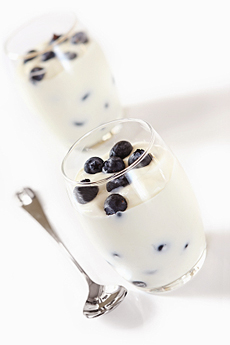 Plain yogurt, fresh blueberries: healthy and heavenly. Photo by Robyn Mackenzie | IST. Plain yogurt, fresh blueberries: healthy and heavenly. Photo by Robyn Mackenzie | IST.
February 2005
Last Updated November 2025
|
 |
Yogurt Glossary
Yogurt Or Yoghurt, Speak The Language Of These Cultures
Page 1: Terms A To F
Yogurt means “to thicken” in Turkish. Here’s the history of yogurt. Master these yogurt terms and definitions, and you’ll be part of the language of fine “culture.” Let us know if you’d like to suggest additional yogurt terms or definitions. Also see our Probiotics Glossary and Glossary Of Organic Terms.
First, a bit of yogurt history (or you can skip to the glossary below).
The History Of Yogurt
The origins of yogurt are unknown, but it is thought to have been invented in Mesopotamia around 5000 B.C.E. As with cheese, it is believed to have been spontaneously fermented by wild bacteria in goatskin bags used to carry milk. The agitation of the milk in the bag on horseback or foot caused the milk to curdle into yogurt.
References to yogurt appear in the records of ancient Greece, India, and Persia. These references often mention consuming honey along with yogurt.
The oldest writings that mention yogurt are attributed to Pliny the Elder (23 C.E.-79 C.E.). He remarked that certain “barbarous nations” knew how “to thicken the milk into a substance with an agreeable acidity” [source].
- Medieval Turkish sources in the 11th century describe the use of yogurt by nomadic Turks.
- Sources suggest that Mughal Indian emperor Akbar's (1605-1556) cooks would flavor yogurt with mustard seeds and cinnamon.
- French king Francis I (1494-1547) suffered from severe diarrhea, which no French doctor could cure. His ally Suleiman the Magnificent of Turkey sent a doctor, who purportedly cured the patient with yogurt.
Yogurt In Modern Times
Until the 1900s, yogurt was a staple in the diets of people in the Russian Empire, especially Central Asia and the Caucasus, Western Asia, South Eastern Europe/The Balkans, Central Europe, and the Indian subcontinent.
The first scientific study of yogurt was done by Stamen Grigorov (1878–1945), a Bulgarian medical student in Geneva. In 1905, he examined the microflora of the Bulgarian yogurt and described it as consisting of spherical and rod-like lactic acid-producing bacteria. In 1907, the rod-like bacterium was called Bacillus bulgaricus (now Lactobacillus delbrueckii subsp. bulgaricus).
The Russian biologist and Nobel laureate Ilya Mechnikov, of the Institut Pasteur in Paris, was influenced by Grigorov’s work and hypothesized that regular consumption of yogurt was responsible for the unusually long lifespans of Bulgarian peasants. Believing Lactobacillus to be essential for good health, Mechnikov worked to popularize yogurt as a foodstuff throughout Europe.
Isaac Carasso industrialized the production of yogurt. Carasso, originally from the city of Salonica in the Ottoman Empire, started a small yogurt business in Barcelona, Spain In 1919. He named the business Danone (“little Daniel”) after his son. The brand later expanded to the U.S. under the name Dannon.
Yogurt was introduced to the U.S. in the first decade of the 20th century as a health food, influenced by Élie Metchnikoff's 1908 book, The Prolongation of Life; Optimistic Studies
Yogurt was popularized by John Harvey Kellogg at the Battle Creek Sanitarium, and later by Armenian immigrants Sarkis and Rose Colombosian, who established Colombo and Sons Creamery in Massachusetts in 1929.
Yogurt's popularity in the U.S. evolved in the 1950s and 1960s, when it was presented as a health food by scientists like Hungarian-born bacteriologist Stephen A. Gaymont. Plain yogurt proved too tart for the American palate, so in 1966 Colombo sweetened its yogurt by adding fruit preserves, creating the “fruit on the bottom” style of yogurt, called sundae style in the industry. It was a big success, causing other brands to do the same.
By the late 20th century, yogurt had become a common American food item and Colombo Yogurt was sold in 1993 to General Mills—which discontinued the brand in 2010. Today, the number of different brands of yogurt in a supermarket is dazzling, including not just American products but imports.
Click on a letter of the alphabet:
a b c d e f g h i j k l m n o p q r s t u v w x y z
This material is copyrighted and cannot be reproduced in whole or in part.
ACIDOPHILIS
See L. acidophilus.
ACTIVE YOGURT CULTURES or LIVING YOGURT CULTURES
In some techniques of yogurt-making, the bacteria survive processing, so packages will be thusly labeled. In other techniques, the milk is pasteurized again after the cultures are added, so the bacteria are destroyed. These packages are labeled “heat-treated after culturing.”
AUSTRALIAN-STYLE YOGURT
Like conventional yogurt, Australian yogurt is unstrained, but it’s cooked more slowly and longer than regular yogurt. This delivers a creamier texture that is somewhere between traditional and Greek yogurt in thickness. In the U.S., the brand is represented by Wallaby Yogurt, a California company. The founders were inspired by the yogurts they “discovered” while traveling in Australia. We find no discernible difference from the already established terms for this creamy style of yogurt with fruit blended in (as opposed to sundae-style, fruit at the bottom of the cup): custard-style, French-style, or Swiss-style. (The company also makes a fruit-at-the-bottom line.)
|
|
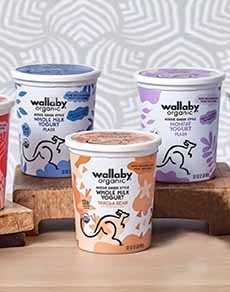
The only “Australian-style” yogurt we’ve come across in the U.S. (photo © Wallaby Yogurt). |
BACTERIA
Yogurt is made by curdling milk with purified cultures of two special bacteria, Lactobacillus bulgaricus and Streptococcus thermophilus. The other commonly used strains are Bifidus, L. Acidophilus, and S. Thermophilus. In an attempt to make their products sound more exclusive, some large manufacturers are creating strains with proprietary names, such as Dannon’s L. casei Immunitas™ and Bifidus Regularis™. These strains have no greater functional powers than the publicly available bacteria. As you may deduce from the names “Immunitas” and “Regularis,” this is product marketing razzelis dazzelis.
BASIC YOGURT
Yogurt is created and thickened by adding cultures to milk. This creates the tangy, sour flavor that helps to define yogurt. First, the milk is heated to prevent curds from forming. Then, it is cooled, and a bacterial culture is mixed in (see description above). Most yogurt has live and active cultures (probiotics) that promote gut and digestive health. The traditional yogurt Americans are used to has a smooth, creamy texture. It is unstrained, so it’s not as thick as other yogurt options, but it’s still too thick to drink.
BIFIDUS
A strain of beneficial bacteria that is often included in probiotic cultures. See also probiotic.
BUTTERMILK
Buttermilk is related to yogurt in that it is a fermented (cultured) dairy product. Originally, buttermilk was the liquid left over from churning butter from cream, now called traditional buttermilk. Cultured buttermilk is made by adding lactic acid bacteria to cow’s milk. Either method produces tart-flavored milk, due to the presence of the lactic acid in the milk; buttermilk is also thicker than plain milk, although traditional buttermilk is thinner than cultured buttermilk. Rich buttermilk is enjoyed as a beverage and used in batters (breading, cake, and pancake, for example). See also kefir.
|
|
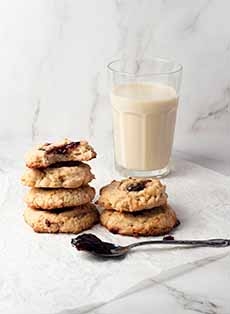
[Butter]milk and cookies (photo CCO PublicDomain). |
CULTURED
Made with live bacterial cultures. All yogurt is cultured, and thus is more digestible than milk for some people with lactose intolerance. The live cultures create lactase, an enzyme in which lactose-intolerant people are deficient, and aid in the digestion of casein, a milk protein.
CUSTARD-STYLE YOGURT
Yogurt with a custard-like consistency in which the fruit is already mixed in and distributed evenly throughout. Also called French style and Swiss style. Many products called Custard- French- and Swiss-style are marketing inventions, “laboratory products,” whether they are artificially flavored and colored or naturally colored, thickened, stabilized, and preserved to a pudding-like hardness. Real yogurt is silky and velvety (except for Greek style, which is deliberately thicker). While the ancient Greeks (and the original inventors of yogurt, no doubt) ate fruit with yogurt, the yogurt they ate was a supple product, not stiffened to hold its form. Even though ingredients such as agar, carrageenan, gelatin, guar gum, locust bean gum and other additives are “natural” and enable products to be called 100% natural, look for products that have none of these. |
|
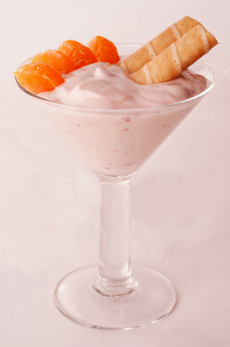
Custard-style yogurt is creamy and pudding-like. Photo by d2xed | IST. |
DAIRY-FREE or NONDAIRY YOGURT
Vegans and others who don’t consume dairy products can find non-dairy yogurts made from almond, cashew, coconut, and oat milks, and even nondairy yogurt made from the pili nut of Southeast Asia.
DRINKABLE YOGURT
Drinkable yogurt is a category with a variety of consistencies, from thinner (like milk) to thicker (like a somewhat thinner version of traditional yogurt. In addition, brands line the spectrum from tart to sweet. Some are salty and savory. Different countries have their preferred styles. Examples include Called ayran from Turkey and other parts of the Middle East, kefir from western Eurasia, and lassi from Pakistan and India. Smoothies, which became popular in the U.S. in the 1980s, are also drinkable yogurt.
|
|
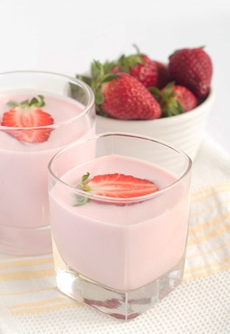 French-style yogurt is cultured in its individual jars (photo © Oui By Yoplait). French-style yogurt is cultured in its individual jars (photo © Oui By Yoplait). |
EUROPEAN-STYLE YOGURT or STIRRED CURD METHOD
A style of yogurt in which the yogurt is cooked in a large vat instead of in individual cups. This enables the curds to be stirred in the vat before they are poured into the cups, resulting in a smoother, creamier yogurt. Emmi Swiss Yogurt and Straus Organic Yogurt are examples.
FRENCH YOGURT or FRENCH-STYLE YOGURT
French-style yogurt is unstrained like traditional yogurt, and has the same smooth and creamy texture as custard-style yogurt. But instead of being made in a large vat and then divided into containers, French-style yogurt is cultured in the individual-sized containers in which it is sold. It is not sweetened as much as American yogurts. In the U.S., the style is represented by Oui French Style Yogurt, which is made by Yoplait.
|
|
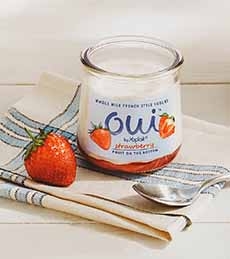 French-style yogurt is cultured in its individual jars (photo © Oui By Yoplait). French-style yogurt is cultured in its individual jars (photo © Oui By Yoplait). |
FROZEN YOGURT
Yogurt that has been prepared in the style of hard or soft-serve ice cream. Generally not a healthy alternative to other treats, it is parallel to ice cream in sugar and fat content. Some brands also have added whole milk or cream for richness. Freezing destroys most of the beneficial, live bacteria. While the FDA has standards for bacterial cultures required to make refrigerated yogurt, no standard of identity exists for frozen yogurt products. They may or may not contain live and active cultures: Read the label, along with this information on live and active cultures in frozen yogurt.
|
|
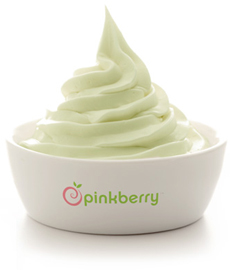 Frozen yogurt can be hard or soft serve (above). Photo of green tea frozen yogurt courtesy Pinkberry. Frozen yogurt can be hard or soft serve (above). Photo of green tea frozen yogurt courtesy Pinkberry. |
Continue To Next Glossary Page, Terms G To N
Go To Index At Top Of Page

|










